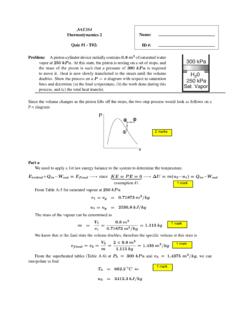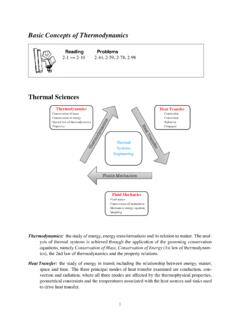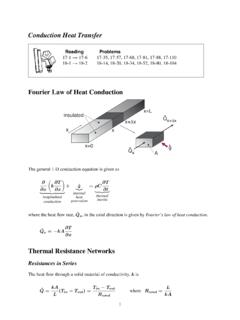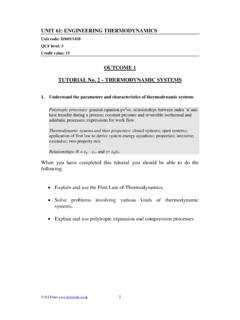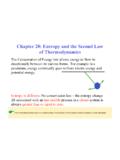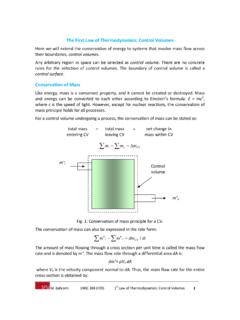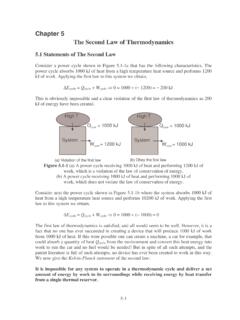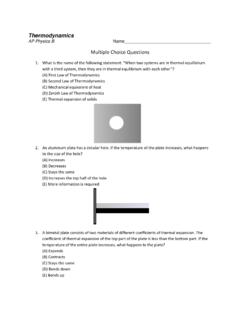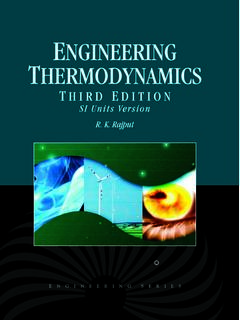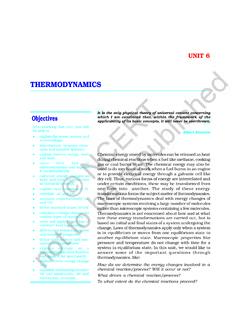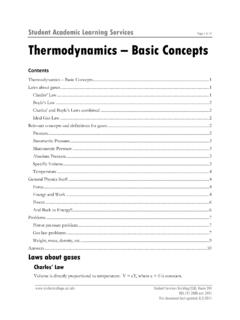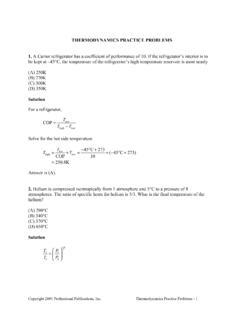Transcription of Chapter 1: Basic Concepts of Thermodynamics
1 Chapter 1, E&CE 309, Spring 2005. Majid Bahrami 1 Chapter 1: Basic Concepts of Thermodynamics Every science has its own unique vocabulary associated with it. Precise definition of Basic Concepts forms a sound foundation for development of a science and prevents possible misunderstandings. Careful study of these Concepts is essential for a good understanding of topics in Thermodynamics . Thermodynamics and Energy Thermodynamics can be defined as the study of energy, energy transformations and its relation to matter. The analysis of thermal systems is achieved through the application of the governing conservation equations, namely Conservation of Mass, Conservation of Energy (1st law of Thermodynamics ), the 2nd law of Thermodynamics and the property relations. Energy can be viewed as the ability to cause changes. First law of Thermodynamics : one of the most fundamental laws of nature is the conservation of energy principle.
2 It simply states that during an interaction, energy can change from one form to another but the total amount of energy remains constant. Second law of Thermodynamics : energy has quality as well as quantity, and actual processes occur in the direction of decreasing quality of energy. Whenever there is an interaction between energy and matter, Thermodynamics is involved. Some examples include heating and air-conditioning systems, refrigerators, water heaters, etc. Dimensions and Units Any physical quantity can be characterized by dimensions. The arbitrary magnitudes assigned to the dimensions are called units. There are two types of dimensions, primary or fundamental and secondary or derived dimensions. Primary dimensions are: mass, m; length, L; time, t; temperature, T Secondary dimensions are the ones that can be derived from primary dimensions such as: velocity (m/s2), pressure (Pa = ).
3 There are two unit systems currently available SI (International System) and USCS (United States Customary System) or English system. We, however, will use SI units exclusively in this course. The SI units are based on decimal relationship between units. The prefixes used to express the multiples of the various units are listed in Table 1-1. Table 1-1: Standard prefixes in SI units. MULTIPLE 1012 109 106 103 10-2 10-3 10-6 10-9 10-12 PREFIX tetra, T giga, G mega, M kilo, k centi, c mili, m micro, nano, n pico, p Chapter 1, E&CE 309, Spring 2005. Majid Bahrami 2 Important note: in engineering all equations must be dimensionally homogenous. This means that every term in an equation must have the same units. It can be used as a sanity check for your solution. Example 1: Unit Conversion The heat dissipation rate density of an electronic device is reported as mW/mm2 by the manufacturer.
4 Convert this to W/m2. Closed and Open Systems A system is defined as a quantity of matter or a region in space chosen for study. The mass or region outside the system is called the surroundings. Fig. 1-1: System, surroundings, and boundary Boundary: the real or imaginary surface that separates the system from its surroundings. The boundaries of a system can be fixed or movable. Mathematically, the boundary has zero thickness, no mass, and no volume. Closed system or control mass: consists of a fixed amount of mass, and no mass can cross its boundary. But, energy in the form of heat or work, can cross the boundary, and the volume of a closed system does not have to be fixed. Open system or control volume: is a properly selected region in space. It usually encloses a device that involves mass flow such as a compressor.
5 Both mass and energy can cross the boundary of a control volume. Important note: some Thermodynamics relations that are applicable to closed and open systems are different. Thus, it is extremely important to recognize the type of system we have before start analyzing it. Isolated system: A closed system that does not communicate with the surroundings by any means. Rigid system: A closed system that communicates with the surroundings by heat only. SYSTEMBOUNDARY SURROUNDINGS Chapter 1, E&CE 309, Spring 2005. Majid Bahrami 3 Adiabatic system: A closed or open system that does not exchange energy with the surroundings by heat. Fig. 1-2: Closed system, mass cannot cross the boundaries, but energy can. Fig. 1-3: Control volume, both mass and energy can cross the boundaries. Energy In Thermodynamics , we deal with change of the total energy only.
6 Thus, the total energy of a system can be assigned a value of zero at some reference point. Total energy of a system has two groups: macroscopic and microscopic. Macroscopic forms of energy: forms of energy that a system posses as a whole with respect to some outside reference frame, such as kinetic and potential energy. The macroscopic energy of a system is related to motion and the influence of some external effects such as gravity, magnetism, electricity, and surface tension. energy mass CLOSED SYSTEM m = energy CONTROL VOLUME Chapter 1, E&CE 309, Spring 2005. Majid Bahrami 4 Kinetic energy: energy that a system posses as a result of its relative motion relative to some reference frame, KE ()kJmVKE22= where V is the velocity of the system in (m/s). Potential energy: is the energy that a system posses as a result of its elevation in a gravitational field, PE ()kJmgzPE= where g is the gravitational acceleration and z is the elevation of the center of gravity of the system relative to some arbitrary reference plane.
7 Microscopic forms of energy: are those related to molecular structure of a system. They are independent of outside reference frames. The sum of microscopic energy is called the internal energy, U. The total energy of a system consists of the kinetic, potential, and internal energies: ()kJmgzmVUPEKEUE++=++=22 where the contributions of magnetic, electric, nuclear energy are neglected. Internal energy is related to the molecular structure and the degree of molecular activity and it may be viewed as the sum of the kinetic and potential energies of molecules. The sum of translational, vibrational, and rotational energies of molecules is the kinetic energy of molecules, and it is also called the sensible energy. At higher temperatures, system will have higher sensible energy. Internal energy associated with the phase of a system is called latent heat.
8 The intermolecular forces are strongest in solids and weakest in gases. The internal energy associated with the atomic bonds in a molecule is called chemical or bond energy. The tremendous amount of energy associated with the bonds within the nucleolus of atom itself is called atomic energy. Energy interactions with a closed system can occur via heat transfer and work. Chapter 1, E&CE 309, Spring 2005. Majid Bahrami 5 Fig. 1-4: Forms of energy. Chapter 1, E&CE 309, Spring 2005. Majid Bahrami 6 Properties of a System Any characteristic of a system is called a property. In classical Thermodynamics , the substance is assumed to be a continuum, homogenous matter with no microscopic holes. This assumption holds as long as the volumes, and length scales are large with respect to the intermolecular spacing. Intensive properties: are those that are independent of the size (mass) of a system, such as temperature, pressure, and density.
9 They are not additive. Extensive properties: values that are dependant on size of the system such as mass, volume, and total energy U. They are additive. Generally, uppercase letters are used to denote extensive properties (except mass m), and lower case letters are used for intensive properties (except pressure P, temperature T). Extensive properties per unit mass are called specific properties, specific volume (v=V/m). Fig. 1-5: Intensive and extensive properties of a system. State and Equilibrium At a given state, all the properties of a system have fixed values. Thus, if the value of even one property changes, the state will change to different one. In an equilibrium state, there are no unbalanced potentials (or driving forces) within the system. A system in equilibrium experiences no changes when it is isolated from its surroundings.
10 Thermal equilibrium: when the temperature is the same throughout the entire system. m V T P T P T P extensive properties intensive properties Chapter 1, E&CE 309, Spring 2005. Majid Bahrami 7 Mechanical equilibrium: when there is no change in pressure at any point of the system. However, the pressure may vary within the system due to gravitational effects. Phase equilibrium: in a two phase system, when the mass of each phase reaches an equilibrium level. Chemical equilibrium: when the chemical composition of a system does not change with time, , no chemical reactions occur. Processes and Cycles Any change a system undergoes from one equilibrium state to another is called a process, and the series of states through which a system passes during a process is called a path. Fig. 1-6: To specify a process, initial and final states and path must be specified.
